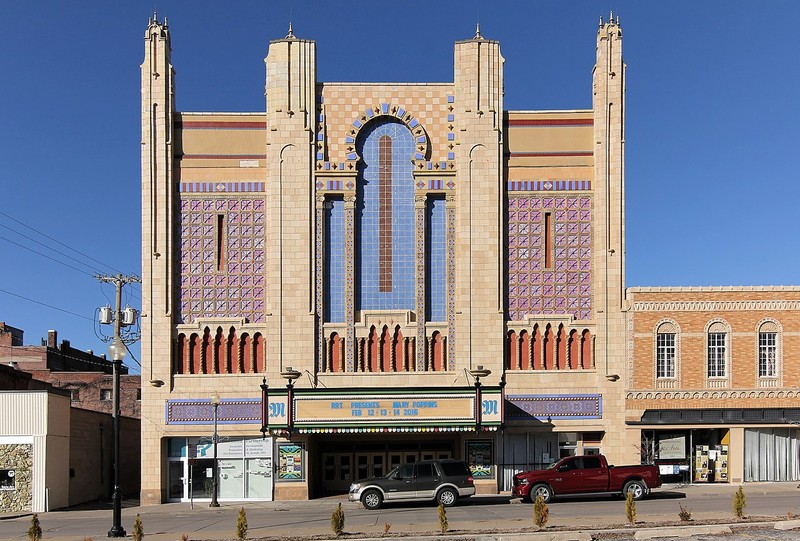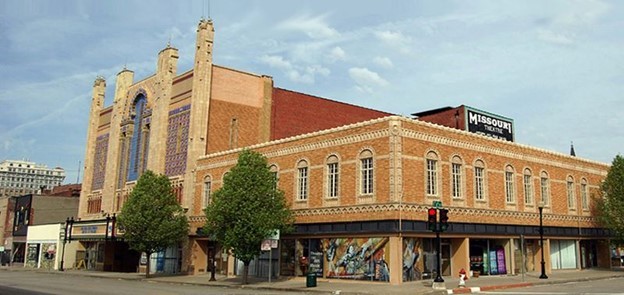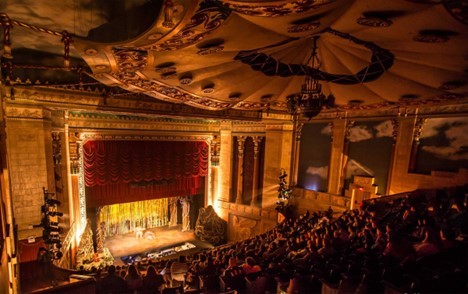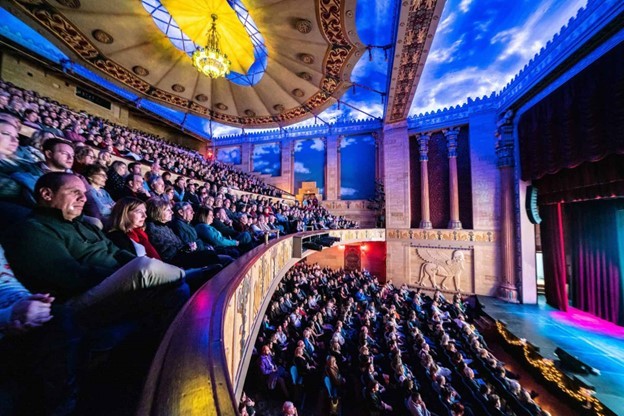Missouri Theater
Introduction
Text-to-speech Audio
The Missouri Theater is located at 717 Edmond Street in Downtown Saint Joseph. Alongside the Robidoux Resident Theatre, it is one of two performance theater venues operating within the community. Whether hosting symphonies, operas, musicals, concerts, or pageants, the Missouri Theater is the premier center for the performing arts. The theater is ADA compliant and has a seating capacity of 1,200.
The Missouri Theater was built in 1927 and is an excellent example of a Great Depression-era movie palace. Its design combines Art Deco and Moorish Revival architecture. The exterior features blue and red tiling, a large Moorish arch in the center and several smaller arches, and four Art Deco piers. The interior can be described as "atmospheric," with Persian motifs and a tent-like canopy hanging from the ceiling. Directly adjoining the theater is a two-story building that was constructed after the theater; both were finished by the time of the grand opening on July 25, 1927. The two buildings were added, together, to the National Register of Historic Places in 1979.
Images
The Missouri Theater is one of the more striking landmarks in St. Joseph. It operates as a performing arts center today.

Historic Missouri Theater

The stunning interior space

It's hard to know what is more impressive -- the performance or the space!

Backstory and Context
Text-to-speech Audio
The theater was the city's main entertainment venue until the end of World War II. Nonetheless, movies continued to be shown here until 1970 and then it became primarily a performing arts center. It was renovated in the late 1970s and again in the early 2000s.
The Missouri Theater is a pre-Depression-era movie house designed by the Boller Brothers architectural firm of Kansas City, Missouri. It opened for business on June 25th, 1927, with the first showing including feature film “Rough House Rosie” starring Clara Bow, an artistic dramatization called “Elegy”, and a 12-minute newsreel. On Sundays and evenings, tickets cost 35 cents for adults and 13 cents for children. Weekday matinees were 25 cents for adults and 10 cents for children. Initially a Publix Amusement house owned by the Paramount Famous Players Corporation, it served as the city’s first-run movie house until the post-World War II era when the entertainment district shifted to the suburbs.
Constructed between 1926-1927, the theater features a distinctive exterior with Arab-Iberian inspired elements, Art Deco piers, and a central arch. Connected to the theater is the Missouri Theater Building, showcasing terracotta ornamentation on its brickwork façade. The external design of the Missouri Theater was immediately iconic. By 1929, another theater, the Isauro Martínez Theater, built as an homage to the Missouri Theater, began operating in Torreón, Coah., Mexico.
Inside the Missouri Theater, visitors will appreciate an atmospheric design with a single balcony and mezzanine. The interior decorations draw upon inspiration from ancient Persian, Babylonian, and Assyrian arts—featuring a plaster canopy tent ceiling, winged human-headed lions, heraldic motifs, friezes, and more. This styling creates an ambiance intended to conjure a fantasized experience inside an ancient Bedouin-inspired desert tent.
The interior aesthetic, accounting for much of the theater’s overall artistic identity, was the work of Baxter Springs, Kansas-born Waylande Gregory, a 20-year-old sculptor and student of Larado Taft. Gregory's prowess manifested in the creation of many captivating sculptures, including the winged bulls and phallic gods which adorn the theater's interior. His innovative fusion of ancient Persian, Arabian, Assyrian, and Hittite influences resulted in an immersive and visually stunning environment within the theater. Beyond the Missouri Theater, Gregory's artistic legacy extends to many other notable area works such as the Hotel President in Kansas City and St. Joseph’s City Hall.
The theater ceased operation as a movie house in 1970 but was saved from possible demolition by Town Hall Center, Inc. Although the Missouri Theater was originally constructed as a movie house, the theater survives to this day, in no small part, to the included original provisions for stage shows—with a large stage, dressing rooms, orchestra pit, fly gallery, and a dimmer board for lights. In 1978, after residents voted for the passing of a $750,000 bond issue, the City of Saint Joseph acquired the building as a center for the performing arts. In 1979, the Missouri Theater became a local landmark and was added to the National Register of Historic Places. Over its lifetime, the Missouri Theater has undergone restoration efforts by local citizens and organizations, emphasizing its cultural and historical significance in St. Joseph. Renovations and alterations include the installation of a snack bar, loge (opera box) and lobby renovations, accessible restrooms, rocker seating, and the removal of the original marquees, art glass, and parapet decoration from the façade.
Sources
"History." Missouri Theater. Accessed February 8, 2019. http://www.stjoearts.org/missouri_theater/history.htm.
Soren, Noelle. "Missouri Theater and Missouri Theater Building." National Park Service - National Register of Historic Places Nomination Form. October 11, 1979. https://dnr.mo.gov/shpo/nps-nr/79001353.pdf.
Photo: Wikimedia Commons
https://en.wikipedia.org/wiki/Missouri_Theater_and_Missouri_Theater_Building#/media/File:MO_Theater_001.jpg
“Missouri Theater Imposing Building”, St Joseph News Press, September 11, 1926.
“Sculpture in Theater”, St Joseph News Press, January 15, 1927.
“Open New Theater Tomorrow Evening”, St Joseph News Press, June 24, 1927.
Noelle Soren, “National Register of Historic Places Inventory Nomination Form”, Missouri Department of Natural Resources, May, 1979, https://mostateparks.com/sites/mostateparks/files/Missouri%20Theater%20and%20Missouri%20Theater%20Building.pdf.
Alejandro Ahumada, “¿De dónde viene el diseño de la fachada del Teatro Isauro Martínez?”, El Siglo de Torreón, March 1, 2020, https://www.elsiglodetorreon.com.mx/noticia/2020/de-donde-viene-el-diseno-de-la-fachada-del-teatro-isauro-martinez.html.
Coverage Photography
